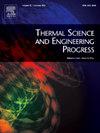工业热交换器与水处理系统集成的循环性评价
IF 5.1
3区 工程技术
Q2 ENERGY & FUELS
引用次数: 0
摘要
促进了工业水循环和再利用战略,以减少淡水消耗。此外,热管换热器技术的成功应用,减少了天然气的消耗,减少了温室气体的排放。评估应用这些循环经济战略的真正好处是很重要的。因此,本工作评估了热管冷凝器省煤器(HPCE)和陶瓷工业水处理系统的集成。此外,屋顶雨水收集被整合到工业中。CE评估方法和选定的指标衡量了从线性经济向循环经济过渡的效率,并确定了优化战略。然而,与资源的提取和流出物的释放有关的人类与自然系统之间的相互作用没有被考虑。这对于理解实现循环操作时的潜在中断非常重要。因此,评估侧重于资源可追溯性、实施行动创造的价值等循环原则,通过资源流动和循环行动指标,量化系统集成的内在循环性。评估结果表明,两种系统的集成和屋顶雨水收集分别使循环水量减少33.73%和用水量减少22.88%。结果表明,高效能ce集成可使回收能贡献率达到19.98%。这表明系统集成在基线场景上增加了循环性能。此外,评估还进行了情景分析,有助于确定进一步改善循环行动的战略,例如减少淡水提取。本文章由计算机程序翻译,如有差异,请以英文原文为准。
Circularity assessment of industrial heat exchanger and water treatment systems integration
Water recycling and reusing strategies in industries have been promoted to reduce freshwater consumption. In addition, Heat Pipe Heat Exchanger technology has been employed successfully, resulting in the reduction of natural gas consumption and mitigating greenhouse gas emissions. It is important to assess the true benefits of the application of these Circular Economy strategies. Therefore, this work assesses the integration of a Heat Pipe Condenser Economiser (HPCE) and a water treatment system in a ceramic industry. Additionally, rooftop rainwater harvesting is integrated into the industry. The CE assessment methodologies and selected indicators measure the efficiency of the transition from a linear to a circular economy and identify strategies for optimisation. However, the interactions between human and natural systems related to the abstraction of resources and release of outflows are not considered. This is important to understand potential disruptions when implementing circular actions. Therefore, the assessment focuses on circular principles such as resource traceability and value created by implemented actions, and through resource flow and circular action indicators, the intrinsic circularity of system integration is quantified. The assessment showed the integration of both systems and the rooftop rainwater harvesting increased the Circular Water Flow and the Water Withdrawal Reduction up to 33.73 % and 22.88 %, respectively. Moreover, it demonstrates that the HPCE integration increased the Recovered Energy Contribution up to 19.98 %. This indicates the system’s integrations increased circular performance over the baseline scenario. Additionally, the assessment enabled a scenario analysis which aided in identifying further strategies to improve the circular actions, such as reducing freshwater withdrawal.
求助全文
通过发布文献求助,成功后即可免费获取论文全文。
去求助
来源期刊

Thermal Science and Engineering Progress
Chemical Engineering-Fluid Flow and Transfer Processes
CiteScore
7.20
自引率
10.40%
发文量
327
审稿时长
41 days
期刊介绍:
Thermal Science and Engineering Progress (TSEP) publishes original, high-quality research articles that span activities ranging from fundamental scientific research and discussion of the more controversial thermodynamic theories, to developments in thermal engineering that are in many instances examples of the way scientists and engineers are addressing the challenges facing a growing population – smart cities and global warming – maximising thermodynamic efficiencies and minimising all heat losses. It is intended that these will be of current relevance and interest to industry, academia and other practitioners. It is evident that many specialised journals in thermal and, to some extent, in fluid disciplines tend to focus on topics that can be classified as fundamental in nature, or are ‘applied’ and near-market. Thermal Science and Engineering Progress will bridge the gap between these two areas, allowing authors to make an easy choice, should they or a journal editor feel that their papers are ‘out of scope’ when considering other journals. The range of topics covered by Thermal Science and Engineering Progress addresses the rapid rate of development being made in thermal transfer processes as they affect traditional fields, and important growth in the topical research areas of aerospace, thermal biological and medical systems, electronics and nano-technologies, renewable energy systems, food production (including agriculture), and the need to minimise man-made thermal impacts on climate change. Review articles on appropriate topics for TSEP are encouraged, although until TSEP is fully established, these will be limited in number. Before submitting such articles, please contact one of the Editors, or a member of the Editorial Advisory Board with an outline of your proposal and your expertise in the area of your review.
 求助内容:
求助内容: 应助结果提醒方式:
应助结果提醒方式:


